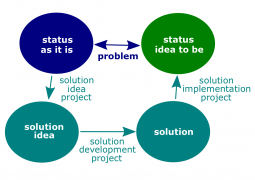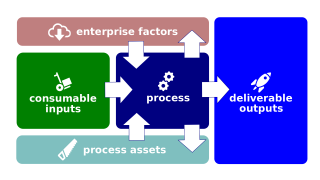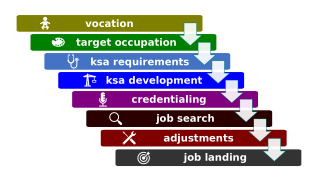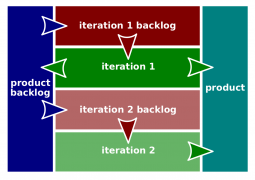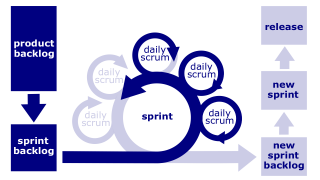What Career Endeavor Is
What Career Endeavor Is (hereinafter, the Lectio) is the second lesson part of the Career Endeavors lesson that introduces its participants to career projects and related topics.
This lesson belongs to the Introduction to Careers session of the CNM Cyber Orientation. The Orientation is the second stage of the WorldOpp Pipeline.
Contents
Content
The predecessor lectio is Career Changes.
Key terms
- Project. One or more enterprise efforts undertaken to create a unique deliverable, functional features of which are identified or can be identified before the efforts start. Any project can be viewed as a set of processes.
- Career waterfall. A sequential process where progress is seen as flowing steadily downwards through the phases. These phases may vary, but often consist of (a) discovering one's vocation, (b) suggesting one's target industry and/or occupation, (c) identifying work-related competence needed for a particular position, (d) development of one's KSAs, (e) development one's employment credentials, (f) job search, (g) adjustments to the job market, and/or (h) landing one's job in the target occupation and/or target industry.
- Agile methodology. The project administration approach of developing the deliverable in frequent iterations based on the requirements that evolve based on the results of previous iterations. The Agile methodology is characterized by frequent reassessment and adaptation of initial objectives. Instead of once-defined projects in the Waterfall model, the Agile methodology encourages continuous re-definition based on continuous feedback. This feature makes the Agile methodology instrumental in those developments that are as inherently unpredictable as most of the career projects are.
Script
- Project. One or more enterprise efforts undertaken to create a unique deliverable, functional features of which are identified or can be identified before the efforts start. Any project can be viewed as a set of processes.
- Reflecting the Work Motivation Model, these goals may refer to improvements in work-life fit, employee compensation, job tasks, or, most likely, some combination of those.
- These endeavors may be either ongoing operations, which are casually called "old businesses", or projects, which are casually called "new businesses".
Attaining competence in the current job, putting in extended work hours, developing new skills, developing new opportunities at work, attaining a mentor, building one’s image and reputation, and engaging in organizational politics.
Attaining competence in the current job is a basic career strategy, given that organizations make promotion decisions, at least in part, on an employee’s present performance. In addition, the skills acquired or honed in one job might be essential for performance in another job either with one’s current employer or with another organization. The concepts underlying the protean and boundaryless career philosophies make it necessary for individuals to have relevant skills at the times when those skills are required by employers. Focusing on developing abilities in a current job can improve an individual’s chances for employability in the future.
Putting in extended hours either at the work site or at home is a popular career strategy, especially in the early career, when an employee is proving himself or herself to the company. Working beyond normal hours can enhance performance in one’s current job and can signify to the organization that one is committed to the job and capable of taking on large volumes of work. However, putting in extended work hours can also result in negative consequences over the longer term, given that extra work hours during evenings and weekends might impinge on the time a person can spend on family or personal activities.
Developing new skills is a career strategy that involves the acquisition or enhancement of work abilities that either improve performance in the present job or will be required in a subsequent position. Michael Arthur, Priscilla Claman, and Robert DeFillippi have called this strategy “knowing how.” They have noted that skill development can involve formal occupational training as well as experiential learning. Skill development can include activities such as participation in training seminars, degree or nondegree university programs, or attendance at a leadership development workshop. Employees can also develop skills by acquiring additional responsibilities on their current jobs, working with an experienced colleague, or joining occupational associations that sponsor continuing education.
Developing new opportunities at work includes a number of more specific strategies that are designed to increase one’s career options. In their typology, Arthur and his colleagues have referred to this career strategy as “knowing whom.” As an example, self-nomination is a frequently observed strategy that involves the willingness to inform superiors of accomplishments, aspirations, and desired assignments. Self-nomination is intended to enhance one’s visibility and exposure to those in more senior positions within the organization, which can bring recognition, special assignments, and sponsorship. Another relevant career strategy under this category is networking, which involves the identification of and communication with a group of relevant acquaintances and friends who can provide information, advice, and support regarding career opportunities.
Attaining a mentor as a career strategy has received considerable attention in recent years. Mentoring can be defined as relationships between junior and senior colleagues or between peers that provide various developmental functions. The mentoring role can be filled by a variety of individuals, not by just one person. A mentor can provide coaching, friendship, sponsorship, and role-modeling to the younger, less experienced protege. In the process, the mentor can satisfy his or her need to have a lasting influence on another person’s life.
Building one’s image and reputation is a career strategy in which the individual attempts to convey an appearance of success and suitability. For example, being married, participating in community activities, and dressing properly can provide a positive public image that can bring career rewards. While this type of strategy is not necessarily important in all or most situations, past research has found that significant numbers of employees make the investment in image building because of the perceived high value to career advancement. Building one’s work reputation is an important strategy because it is presumed that an individual’s past experiences and accomplishments bode well for future performance. Thus, a focus on building a strong work reputation can improve a person’s employability regardless of the employer.
Engaging in organizational politics is somewhat similar to the “knowing why” strategy described by Arthur and his colleagues and covers such diverse activities as agreeing with or flattering one’s supervisor, advocating company practices, not complaining about rules or regulations, and forming alliances or coalitions with others in the organization. More extreme and often personally unacceptable political practices can include sabotaging another person’s work or spreading rumors about a colleague. In many organizations, becoming involved in organizational politics is a career strategy that is necessary for career advancement, although certain behaviors might be viewed as unethical or reprehensible. Nonetheless, regardless of the personal acceptability, engaging in organizational politics is a career strategy that is used regularly.
Foot in a door
Career Waterfalls is the successor lectio.

